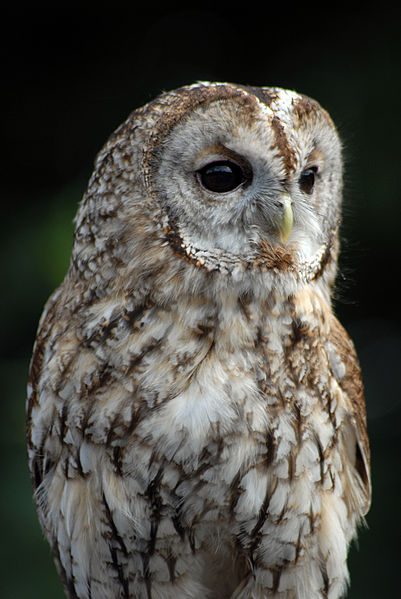Dawn Walk Results in Waves of Song
Steve Hallam led a small group on the annual Dawn Chorus Walk when they were greeted by waves of song. His account of the walk is shown below…
On the morning of 18th May, the population of West Bergholt could be divided into two groups:
- the eight people who came on this year’s Dawn Chorus walk, and
- those who had made a mistake.
This was one of the best ‘shows’ since I have been leading these walks (and this was nothing to do with me!), as I will explain.
 First Contact a Tawny Owl
First Contact a Tawny Owl
For the last two years, slightly embarrassingly, the first bird heard has been a domestic cockerel. So I was quite keen to avoid this fate today. Luckily nature obliged, as a Tawny Owl was heard hooting from behind the hall as we walked down the track. In fact, before long we could hear three Tawny Owls conversing, which was the most I have heard on these walks. (Image right sourced from Wikipedia). Very soon afterwards we also heard a Pheasant and a Wood Pigeon.
Waiting for First Wave
As usual, we paused at the turn in the track to wait for the ‘first wave’ of the Dawn chorus to start; this is normally comprised of Robins, Blackbirds and Song Thrushes. While doing so I was more than a little surprised to hear a brief snatch of unfamiliar song from inside a nearby hedge.
After a little thought, I realised that this was the song of the scarce and easily overlooked Lesser Whitethroat. This bird is easily overlooked because its’ song is unassuming and easily mistaken for that of the more common Yellowhammer. Furthermore, its skulking behaviour in the midst of scrubby bushes means that it is difficult to actually see. But we had one singing at just after 4 in the morning!
Soon afterwards the ‘first wave’ of the chorus rolled into action. Although one difference this year was the Song Thrush that sings from a territory near the concrete footbridge was sadly absent. We did hear one in the distance, but this was not quite the same thing. Now that we had serious ‘singing action’ we continued on to the wood entrance, accompanied by the songs of several Robins and Blackbirds. The Tits normally stay silent until the songsters have quietened down, but this year one Great Tit decided to join it at this point. Arguably an unwise exertion of effort, as only the keenest of ears could make him out.
Blackcaps Lead Second Wave into Wall of Sound
By the time we reach the pond the first of the ‘second wave’, the Blackcaps, normally start to tune up. And so it was this year. Of course, at this point, the big issue is whether or not we will hear Nightingales. So far, in this year’s walk, we had heard none, which was a little unusual. I knew that several territories are occupied this year, but am always on tenterhooks until we hear a first one.
By now the chorus was approaching ‘wall of sound’ status, when so many birds are singing that it becomes challenging to pick any individual out. But, just as we were walking through the triangular path junction one could be heard clearly just ahead. Pressing on down the slope, slightly to my surprise it kept on singing, running through its repertoire of phrases. And kept on, and on, and on. Finally we were standing just five or so metres from its perch, and still it kept singing relentlessly.
I cannot remember a more obliging bird on one of these walks. Finally, thinking that perhaps the novelty might be wearing off for some group members, I decided we should move on and leave him in peace. But what a song!
 Wrens’ Musical Hand Grenades
Wrens’ Musical Hand Grenades
In truth, that was the highlight of the walk. However the chorus kept going longer than in some other years, so even while we were walking along the side of the stream there was still plenty of bird song to accompany us. Wrens were particularly prominent at this point. I always think that their songs sound like furious musical hand grenades, and we had several lobbing fusillades.
We went to the far end of the wood, where there is always an occupied Nightingale territory. For once, nature obliged: just as I explained this, a bird starting singing. Walking back, we stopped to admire the Rhododendrons, which were ablaze with colour.
Songs & Flights to the End
In some years, the walk back along the track to the church can be rather empty, but not this year. Firstly we again heard the Lesser Whitethroat. But, by now (and also unusually) a Yellowhammer was also singing. So we were able to listen to both songs and hear how the latter bird has a ‘thinner’ tone and holds its last note for longer. In addition, two or three Whitethroats were belting out their scratchy song.
Luck was really with me because just after I had explained how an easy way to tell this species is that the male can perform a dancing song flight, the one we were listening to obligingly did one. Finally, as we were approaching the old church we heard our first Chaffinch, and then we were back to the cars and, for me, back into bed.
Steve Hallam





